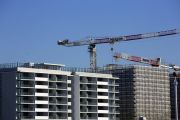
Will big commercial property players ‘confront their demons’?
Property funds and Australian real estate investment trusts (REITs) have been under siege for months, but there may be some light at the end of the tunnel.
With doomsayers prophesizing big downgrades to the values of office towers and their shares trading at up to 25 per cent below their net asset values, the property players have received a much-needed vote of confidence from J.P Morgan.
The investment bank has lifted its outlook for the five ASX-listed REITs, signalling what may be a turning point for the listed property sector. J.P. Morgan’s analyst Richard Jones reckons the sector sell-off, driven by an accelerated move in the 10-year bond yield, is “overplayed”. He says there’s “compelling value” in the market.
However, Jones’ optimism remains out of sync with consensus. According to property advisory and research group Par Group, a further $15 billion could still be written off from values of office and shopping centre assets.
With listed property owners having so far had some $2.5 billion wiped off their books, Par Group says there is more pain ahead. The $2.5 billion equates to a 5 per cent cut in the value in office assets and the cuts are in stark contrast to the limited sales being made.
The biggest problem in assessing real property values is the lack of sales above $50 million.
Many of the funds and the big institutions appear unwilling to test the market. Meanwhile, potential buyers are sitting on their hands, preferring to wait and see where post-COVID valuations settle.
As one commercial property agent, who asked not to be named because of the sensitivity of the matter, put it: “It’s a stalemate. While office owners can handle rising interest rates and partly empty buildings for a while, the reckoning will come. At some point, they will have to confront their demons”
The impasse between buyers and sellers has made it difficult for equity investors to assess the potential of listed property companies – and they have been avoiding them in droves.
The S&P/ASX 200 real estate index is down more than 6 per cent in the past six months alone and 25 per cent from its most recent peak in December 2021.
However, the tide may be turning. With interest rates seemingly near their peak, and their shares already trading well below the total value of their assets, is the worst-case scenario already baked into the property sector?
The sharemarket’s property bears, who have had the upper hand for some time, are still in the majority. However, a more bullish outlook is emerging from a handful of equity market analysts that might develop into a watershed moment.
J.P Morgan has upgraded ASX-listed Vicinity Centres (VCX), Charter Hall Retail REIT (CQR) and Abacus Storage King (ASK) to “overweight” from “neutral.” Its June 2024 price target for Vicinity is $2.10, up 18 per cent on recent trading levels of $1.78. The target for the Charter Hall Retail REIT is $3.90, up 19 per cent from this week’s levels.

Yet, the problem for the property players heavily weighted to office asset exposure remains. The working-from-home phenomenon has left many office towers with vacancy rates significantly above pre-COVID levels, while others are near-empty. And their rental returns are shrinking.
There has also been a flight to quality, with buyers that are left in the market often choosing modern, energy-efficient buildings. Owner-occupiers are also upgrading from their old digs, in a bid to persuade employees to return to the office.
So, what happens to the valuation on the lower-grade office towers that don’t make the cut, and is this market slump just another part of the regular cycle of buying and selling real estate, or has COVID permanently changed the landscape forever?
Until property funds and REITs actually begin to bite the bullet and offload some of their big, empty offices, we probably won’t know.










